Four MORE Flavors of Hall of Fame Ballots
Yesterday, Off the Bench published the Four Flavors of Hall of Fame Ballots, wherein we covered the multitude of ways that people can think through the Hall of Fame Ballot. Some people have already made their ballots public, including LeBron James, with a logic that is less than sound. This is the sequel. The first group of four included the All Sinners Ballot, the All Saints Ballot, the Prickly Personalities Ballot, and the All JAWS Ballot. Today, we’re taking a look at four MORE flavors that promise to be a little bit different than those four.
The Big Bashers Ballot
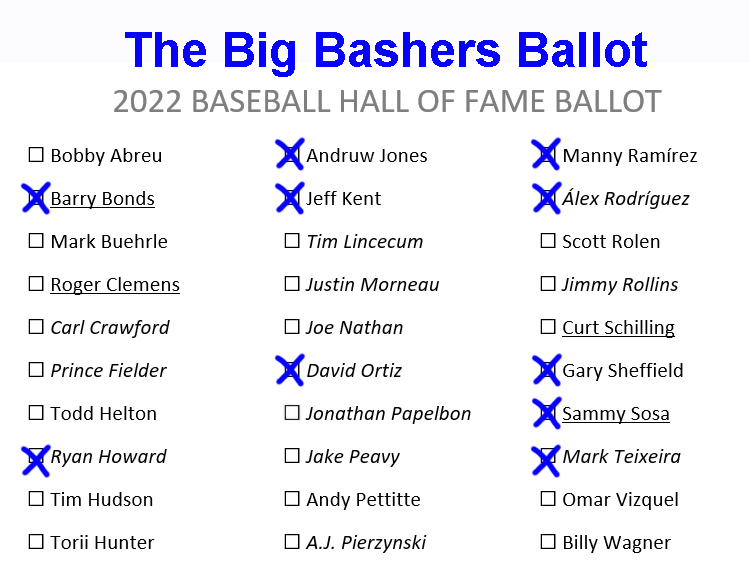
You like dingers? We got dingers. These are the top-10 home run hitters on this Hall of Fame ballot, from the 762 bombs by Barry Bonds to the 377 by Jeff Kent. There are 28 players with 500 or more major league home runs in their career. Ten are not in the Hall of Fame. Six of those players are on this ballot—Bonds, Rodríguez, Sosa, Ramírez, Ortiz, and Sheffield. The other four are Albert Pujols (679), Mark McGwire (583), Rafael Palmeiro (569), and Miguel Cabrera (502). The following chart shows the home run totals for the 10 players listed on the Big Bashers Ballot.
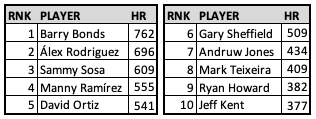
The Awards Galore Ballot
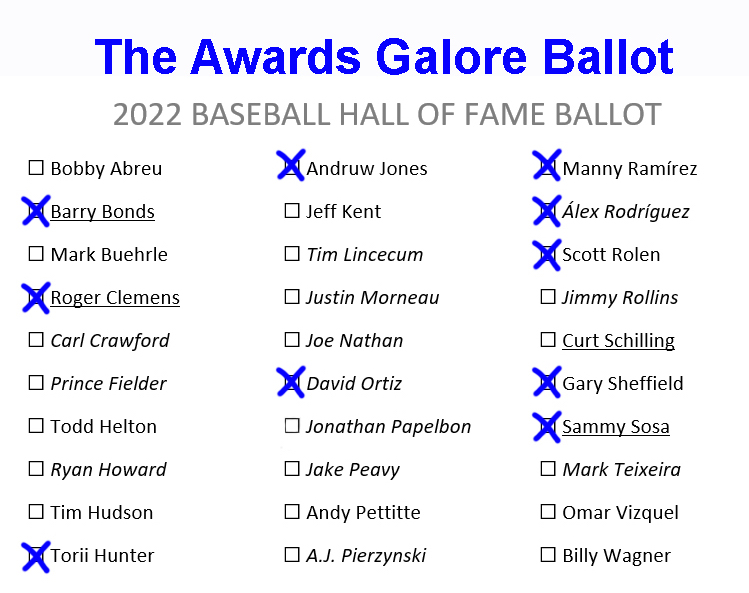
This ballot was created with my made-up-on-the-spot algorithm using an assortment of awards and a points system to determine the top 10 players. This is the “Fame” part of the Hall of Fame. Winning an MVP or Cy Young Award is worth 4 points. A Rookie of the Year Award is worth 3 points. Being an All-Star or the Rolaids Relief Pitcher is worth 2 points. Silver Sluggers and Gold Gloves are worth 1 point.
Bonds is far-and-away on the top of this list with his 7 MVP Awards, 14 All-Star teams, 12 Silver Sluggers, and eight Gold Gloves. Clemens and his 7 Cy Youngs, one MVP Award, and 11 All-Star teams comes in second, just ahead of A-Rod and his 3 MVP Awards, 14 All-Star teams, 10 Silver Sluggers, and 2 Gold Gloves. The rest of the group are bunched closer together, some known more for their hitting—Ramírez, David Ortiz, Sosa, and Sheffield—and others known more for their defense—Rolen, Jones, and Torii Hunter. Here’s the chart for all 10 players:
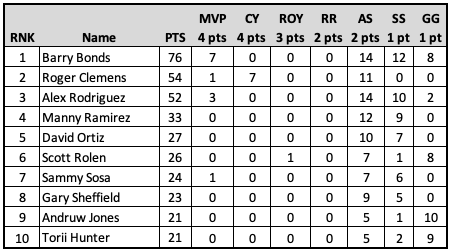
The Better Than You Realize Ballot
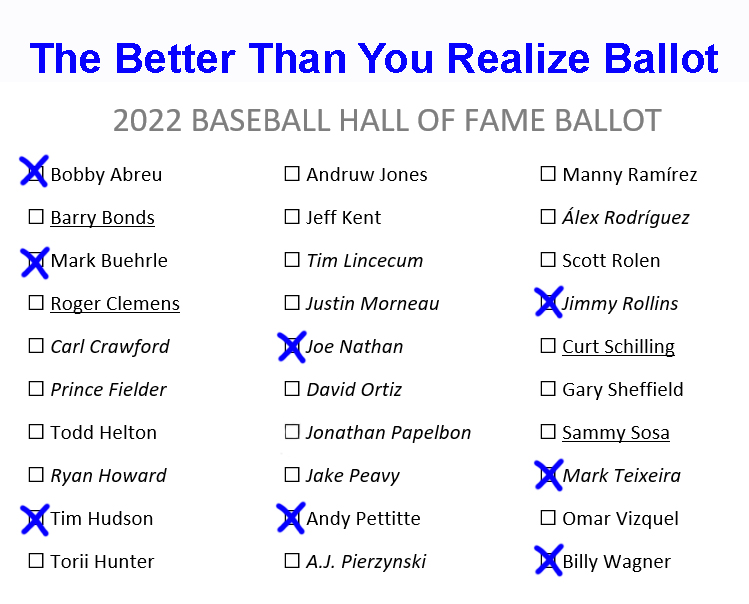
Bobby Abreu was not a particularly exciting player to watch. His best offensive skill was getting on base, often by walking. He stole bases when home runs were king and even though he hit almost 300 homers in his career, his single-season high was 31 in a year in which 31 homers ranked 22nd in the league, That was 2001, when Barry Bonds hit 73, Sammy Sosa hit 64, Luis Gonzalez hit 57, and Shawn Green and Todd Helton each hit 49, so 31 dingers seemed pretty ho-hum. It was a wild time, man. In 2005, Abreu won the Home Run Derby, then came back down to earth in the second half, which many used as more evidence of the “Home Run Derby Curse.” (The curse is a myth)
Despite his lack of pizazz, Abreu was a very good player. Since 1901, only 46 players have reached base more often in their careers than Abreu, who produced at least a hit, a walk, or was hit by a pitch in 3979 games in his career. His 60.2 bWAR is right there with Gary Sheffield, Ichiro, and Vladimir Guerrero among right fielders. His JAWS score slots him in between Hall of Famers Dave Winfield and Vlad.
When it comes to individual seasons, Abreu matches up well with both Winfield and Vlad. In fact, he had more “MVP” level seasons than either (defined as 6 WAR or higher) and the same number of “All-Star” or better seasons as Winfield (and only one fewer than Vlad). Elite seasons should be a major part of any Hall of Fame players resume and Abreu had seven elite seasons. He deserved more than the 8.7 percent of the vote he received last year.
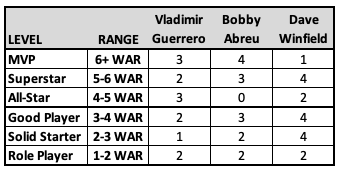
Mark Teixeira may not be Hall of Fame worthy, but he had 12 seasons as a solid starter or better, hit over 400 home runs, and appeared on seven MVP ballots, finishing second in 2009. His best season was 2008, when he was traded from Atlanta to the Angels during the season and hit a scorching hot .358/.449/.632 in 54 games down the stretch.
It will be interesting to see how Jimmy Rollins does in the Hall of Fame voting because statistically he’s as good or better than Omar Vizquel, yet I doubt he’ll get as many votes as Vizquel received in his first year (37 percent). I believe Rollins is better than Vizquel, but I know there’s a segment of the voting populace that LOVES Omar. Or, at least they did before his off-field transgressions came to light.
Some people hate the term “compiler,” but it’s fitting in this case. While he was a below average hitter every year of his career except for two (83 wRC+ overall), Vizquel’s last six seasons were particularly bad, as he hit .250/.305/.310, for a 60 wRC+. Per Baseball-Reference, he was worth a grand total of 0.6 WAR for those six seasons. As the chart below reveals, Rollins had six All-Star or better seasons to Vizquel’s two. Vizquel makes up some ground in “good player” seasons and they had a similar number of “solid starter” seasons.
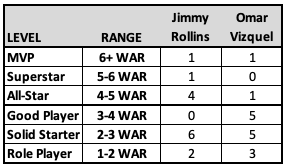
I don’t know what to do with relievers and the Hall of Fame. Trevor Hoffman was elected on his third ballot. In his career, he had 28 WAR while pitching 1089.3 innings. Lance Lynn has 30.2 WAR in 1583.2 innings, but nobody thinks Lance Lynn is on his way to the Hall of Fame. To justify putting a reliever in the Hall of Fame, (other than the GOAT, Mariano Rivera, and Dennis Eckersley, who started 361 games and pitched over 3000 innings) you have to section them off from starting pitchers into their own little category.
Even on the current ballot, Billy Wagner and Joe Nathan don’t come close to starting pitchers Andy Pettitte, Mark Buehrle, and Tim Hudson in career WAR (or career earnings), so unless you adjust for them being relievers, you can’t put them in. Here’s a thought experiment: if you were a GM and knew you would get exactly what each of these pitchers did in their careers, would you take either of the relievers over any of the three starters? I would take any one of Pettitte, Buehrle, or Hudson over Wagner or Nathan.
So, for these purposes, let’s keep relievers in their own separate category. Let’s compare Wagner and Nathan to the other relievers in the Hall. They aren’t up there with Mariano Rivera, Dennis Eckersley, Hoyt Wilhelm, or Goose Gossage, but they aren’t far off from Trevor Hoffman, and they’re better than Lee Smith, Rollie Fingers, and Bruce Sutter. Maybe not in the elusive quality of famous humans recognizable across the globe, but statistically they were better.
I wrote extensively about Andy Pettitte, Mark Buehlre, and Tim Hudson last January, so if you want the full rundown, check that piece out. The bottom line is that BBWAA voters will need to make adjustments for starting pitchers from more-recent eras as baseball strategy has evolved. In the case of this trio, not only did starting pitchers during their era pitch fewer innings than in previous eras, these three pitchers came into the league when offense was soaring and that should be taken into account when considering their Hall of Fame cases.
I used this chart in the piece linked above. It shows how many starting pitchers were inducted into the Hall of Fame based on the 10-year stretch in which they were born.
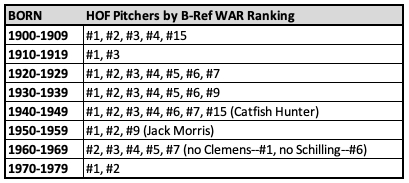
Just two pitchers born from 1970-1979 are in the Hall of Fame (Pedro Martinez and Roy Halladay). By Baseball-Reference WAR, the next three are Pettitte, Buehrle, and Hudson (see below). Is it reasonable to think only two pitchers born in the 1970s were Hall of Fame worthy?
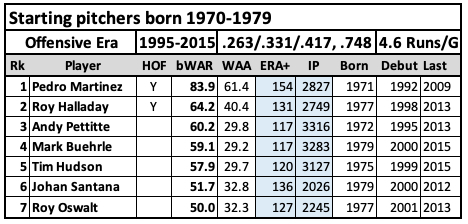
The Leftovers Ballot
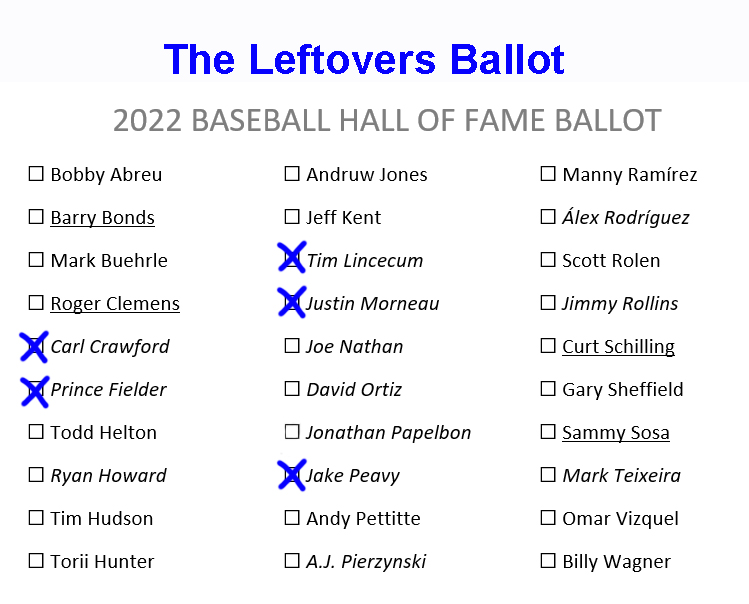
There are five players on the 2022 Hall of Fame Ballot who haven’t appeared on any of the hypothetical ballots from this article or the previous one, so I wondered if we could craft together a Hall of Fame career using these remaining players? This would be a Shohei Ohtani-type player who both pitches and hits, but never in the same season. For example, we’ll use Tim Lincecum’s back-to-back Cy Young seasons in 2008 and 2009, then Carl Crawford’s 2010 season and Prince Fielder’s 2011. What kind of career would this bizarro-world player have?
These five remaining players are Prince Fielder, Tim Lincecum, Jake Peavy, Carl Crawford, and Justin Morneau, so we’ll smush them all into one player and call him Prince TimJake Crawneau. His “career” is shown below.
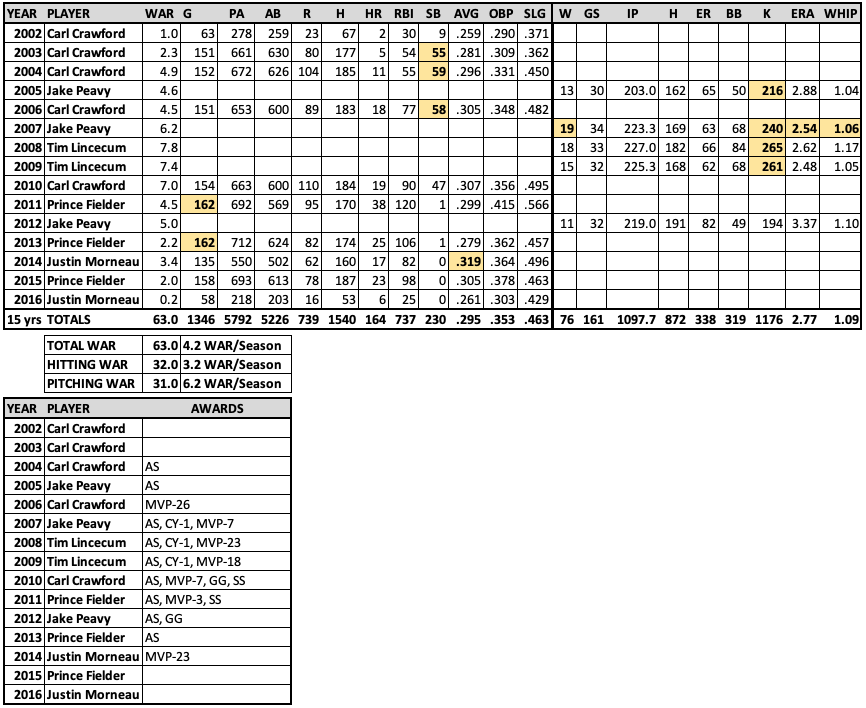
Our hypothetical player named Prince TimJake Crawneau came up as a speedy outfielder in 2002, playing in 63 games and showing some promise. He then led the league in steals in back-to-back seasons as a fixture at the top of the order, becoming an All-Star for the first time in 2004. That offseason, in a moment of inspiration when reminiscing about how much he had dominated from the mound in Little League, he decided to try his hand at pitching in the big leagues. Then he went out and made the All-Star team again, only as a pitcher this time, and led the NL in strikeouts in 2005.
While pitching was fun for Prince TimJake Crawneau, he missed his days as an everyday player, so he went back to left field for the 2006 season and once again led the league in steals. That offseason, feeling like he had accomplished what he wanted to accomplish as a regular player for the time being, he devoted the next three years exclusively to pitching and won back-to-back-to-back Cy Young Awards, leading the league in strikeouts all three years. He also began a stretch of seven straight seasons as an All-Star in his first Cy Young season.
After his three-year stretch as the league’s best pitcher, he returned to the outfield one last time and had an impressive 7-WAR season, hitting a now career-high 19 homers and stealing 47 bases. The home run surge felt so good that he decided to train his body to be a power hitter after the 2010 season, arrived at spring training about 50 pounds heavier, and proceeded to double his home run total from the previous year, hitting 38 bombs and driving in 120 runs.
All those homers must have worn him out a bit, because he eschewed hitting for the pitcher’s mound for one final season in 2012 and struck out 194 batters in 219 innings. Then it was back to hitting. Over the last four years of his career, Prince TimJack Crawneau returned to his slugging ways with seasons of 25 and 23 homers and 106 and 98 RBI.
In his 15-year career, Prince TimJack Crawneau earned 63 WAR—32 as a hitter and 31 as a pitcher. He was an All-Star nine times, a three-time Cy Young Award winner, won two Gold Gloves, two Silver Sluggers, and was named on seven MVP ballots. Is that Hall of Fame worthy?
Is it time to stop the madness? It probably is… for now….
-Bobby Mueller
















